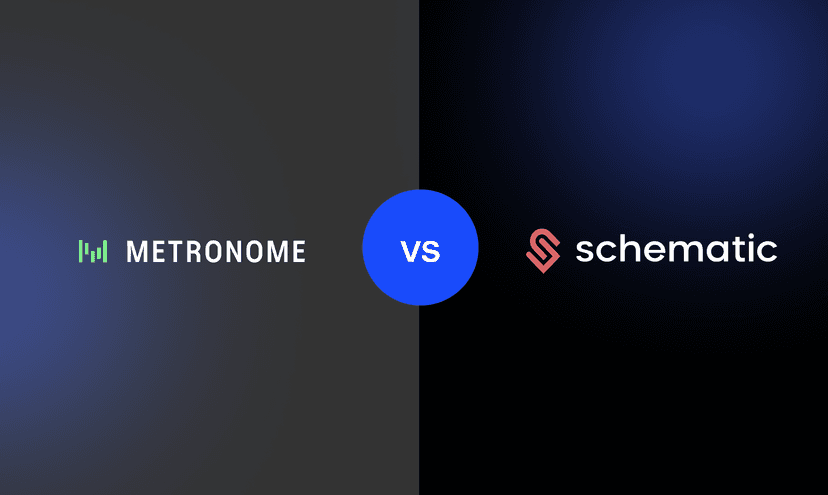

For SaaS and AI teams, monetization can't be an afterthought. It affects how fast you can launch new pricing, whether limits are enforced reliably in-product, and how revenue gets booked. In fast-moving markets, the tighter the link between pricing decisions and product behavior, the bigger the edge.
Schematic and Metronome both see traditional billing systems as too rigid. Each offers a more flexible foundation, but their emphasis differs. For many companies, the deciding factor is how directly billing connects to the product experience.
Schematic centers on speed and product integration, layering entitlements, usage, and drop-in buyer experiences on top of Stripe.
Metronome operates as a heavy-duty billing engine: it ingests usage events, turns them into billable metrics, and generates invoices across Stripe, marketplaces, or ERP. Teams are on the hook to build their own gating, dashboards, and customer-facing flows around it.
This article breaks down how Schematic and Metronome approach billing, what those choices mean in practice, and where each platform is strongest.
Metronome | Schematic | |
Core focus | Event ingestion → billable metrics → products/contracts → invoices; power tool for complex enterprise models. | Extend Stripe with product-layer monetization (plans, entitlements, limits, and drop-in buyer-facing UX). |
Enforcement | Emits alerts and webhooks as thresholds are hit; application must implement gating, paywalls, and dashboards. | Runtime flags return access + limits in one check; easy to enforce or upsell directly in the app. |
Metrics | Flexible billable metrics, rate cards, and contracts with credits, commits, and overrides. | Practical SaaS/AI meters tied to features: counts, quotas, credit burndown, and overages. |
Billing outputs | Generates detailed invoices (scheduled and usage-based) and exports them to Stripe, marketplaces, or ERP. | Keeps Stripe as the invoicing engine while syncing plans/usage and shipping the customer portal + checkout. |
Customer & Dev UX | API-first; teams build portals, upgrade flows, and usage dashboards around Metronome’s data and alerts. | Ships a ready-made Portal, Checkout, and Pricing Table plus SDKs/flags for enforcement—less custom UI to build. |
Time to value | Typically weeks–months to wire gating, portals, and invoice presentation around the billing core. | Days to launch live pricing changes and in-product enforcement with minimal engineering effort. |
Metronome is designed to calculate usage and contracts, then notify your systems when thresholds or balances change. Enforcement is left to the application. You build the logic for gating features, showing usage limits, or triggering an upgrade.
Schematic makes entitlements part of the product itself. Plans are expressed as features and limits, and a runtime flag check tells your app whether the user still has access. That same check can also trigger a paywall or upgrade via built-in components, closing the loop between pricing and product with minimal glue code.
Metronome treats usage events as raw input. You define billable metrics on top of those events, then connect them to products, rate cards, and contracts. This separation gives finance and RevOps fine-grained control over credits, commits, dimensional pricing, and contract-specific schedules.
Schematic takes a more product-oriented approach. Meters are defined in terms of features customers actually buy, such as API calls, seats, document limits, or credit packs. Common SaaS/AI patterns like credit burndown or overages are supported directly making pricing logic easier to reason about. Because Schematic is the source of truth for plan and usage data, teams can adjust pricing and packaging safely without redeploying code.
Metronome’s strength is in how it produces invoices. It can create both scheduled and usage-based invoices, manage draft and finalized states, and export them to Stripe, marketplaces, or ERP systems. Finance teams get precision and flexibility, but product teams still need to layer on the customer experience.
Schematic, by contrast, leans on Stripe for invoicing, payments, and tax. Plans and usage sync seamlessly, while the buyer-facing surfaces (Portal, Checkout) ship out of the box. For teams already on Stripe, this keeps billing straightforward and avoids migrating off of a system they already trust.
Both systems support safe versioning of plans and price changes. Metronome uses separate concepts for products, rate cards, and contracts. That allows overrides, discounts, and credits to be layered without touching the underlying event stream.
Schematic lets GTM teams can adjust plans, quotas, or entitlements directly in configuration, and those changes propagate through to enforcement and the buyer experience instantly. Flags make the updates live in-product without waiting for a deploy, so experimenting with packaging, refining limits, or rolling out new usage models is both fast and low-risk.
Metronome provides a robust API surface—usage ingestion, metrics, contracts, alerts, and invoice exports. But you’ll assemble the customer portal, dashboards, gating, and upsell flows yourself. That makes it highly customizable, but it’s also a bigger lift upfront and more ongoing maintenance.
Schematic was built for speed. The SDK and runtime flags give developers a simple enforcement path, while GTM teams get a Portal, Checkout, and Pricing Table to work with on day one. Pricing changes map automatically to Stripe, so experiments move quickly without engineering bottlenecks.
Schematic and Metronome both represent the new generation of billing platforms: programmable, flexible, and built for SaaS and AI companies.
The difference is in orientation:
Metronome = billing engine for enterprise scenarios: It excels at complex contracts, credits, and commits, and produces rich invoices that feed into Stripe, marketplaces, or ERP. Teams must build their own product-facing surfaces on top.
Schematic = product-first speed: Stripe-centric, entitlement-aware, and packaged with ready-to-ship components, it makes pricing feel like part of the product while letting GTM teams move fast.
If your priority is invoice fidelity and enterprise contract logic (and you’re ready to invest engineering time), Metronome is a strong option. If your focus is velocity, in-product enforcement, and a polished buyer experience on Stripe, Schematic will get you there faster.